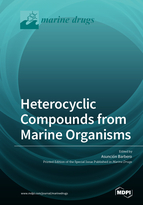Heterocyclic Compounds from Marine Organisms
A special issue of Marine Drugs (ISSN 1660-3397).
Deadline for manuscript submissions: closed (31 October 2022) | Viewed by 34450
Special Issue Editor
Interests: heterocyclic chemistry; organosilanes; natural products synthesis; multicomponent reactions
Special Issues, Collections and Topics in MDPI journals
Special Issue Information
Dear Colleagues,
Marine natural products have played an important role in the development of new bioactive compounds with a variety of interesting properties (antiviral, cytotoxic, antitumor, anti-inflammatory, antimicrobial, and others). Within the molecules these marine organisms produce, the presence of heterocyclic subunits is quite frequent. The structural diversity of this group of marine compounds, together with their diverse biological activities, have attracted the attention of the scientific community. This Special Issue on "Heterocyclic Compounds from Marine Organisms" aims to provide an overview of the most recent developments related to the isolation, characterization, synthesis or biosynthesis of marine compounds containing heterocyclic units or their analogs.
As Guest Editor, I cordially invite contributions in the form of original research articles or reviews from this exciting research field.
Prof. Dr. Asunción Barbero
Guest Editor
Manuscript Submission Information
Manuscripts should be submitted online at www.mdpi.com by registering and logging in to this website. Once you are registered, click here to go to the submission form. Manuscripts can be submitted until the deadline. All submissions that pass pre-check are peer-reviewed. Accepted papers will be published continuously in the journal (as soon as accepted) and will be listed together on the special issue website. Research articles, review articles as well as short communications are invited. For planned papers, a title and short abstract (about 100 words) can be sent to the Editorial Office for announcement on this website.
Submitted manuscripts should not have been published previously, nor be under consideration for publication elsewhere (except conference proceedings papers). All manuscripts are thoroughly refereed through a single-blind peer-review process. A guide for authors and other relevant information for submission of manuscripts is available on the Instructions for Authors page. Marine Drugs is an international peer-reviewed open access monthly journal published by MDPI.
Please visit the Instructions for Authors page before submitting a manuscript. The Article Processing Charge (APC) for publication in this open access journal is 2900 CHF (Swiss Francs). Submitted papers should be well formatted and use good English. Authors may use MDPI's English editing service prior to publication or during author revisions.
Keywords
- heterocycles
- synthesis
- biosynthesis
- marine drugs
- analogs







